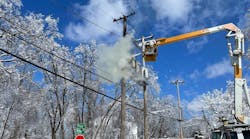On a conference call presented by the National Rural Electric Cooperative Association (NRECA), several cooperative CEOs compared the COVID-19 pandemic to a storm.
“This is just a different type of storm that we haven’t seen before, but a storm after a fashion and we have been preparing for storms for a long time,” said Tony Anderson, CEO at Michigan’s Cherryland Electric Cooperative.
Jim Matheson, NRECA’s CEO, said throughout the coronavirus outbreak, utility co-ops have had to find new and innovative ways to help each other and their customers.
“Preparing for emergencies is something we do a lot. This one is a little different,” Matheson said, adding that electric cooperatives provide power for one in eight people in the United States.
Matheson said rural cooperatives are now preparing to sequester key employees at crucial sites, much like larger utilities and grid operators are doing.
“That includes buying a bunch of supplies like cots and food and I guess just locking folks in and making sure they can do their jobs safely,” Matheson said. “One co-op I talked to was buying a washer and dryer set.”
Dwayne Cartwright, CEO at South Carolina’s Berkeley Electric Cooperative, said he believes you must take care of yourselves first so you can then take care of your members.
“When we learned it was going to be a pandemic, we shut down each of our four districts and had the employees stay within their district,” Cartwright said, adding some new electronics had to be sent out to different offices and to certain employees so they could be properly set up for home work.
Anderson said it took his people roughly a week to get set up so that as many people as possible could do their jobs from home.
“We have a skeleton crew at the office. I have an office run by one person, a workshop with one person and a warehouse run by one person. Everyone in the field is in a vehicle with just one person,” Anderson said, describing his cooperative’s social distancing measures.
Another interesting change Anderson has seen is people looking to their utility for non-utility related assistance.
“Our call volume hasn’t gone up, but the length of the phone calls has. We get calls from people who need to find food banks and other community services,” Anderson said, adding that his coop has become a de facto community service organization.
“People have trusted us for years and it turns out in this situation they are trusting us to provide them with this information in an emergency,” Anderson said.
Matheson said cooperatives will continue to us the utility mutual assistance network to share personnel and equipment, however to do this safely, they will need access to testing kits and personal protective equipment (PPE), which are two things that are in short supply.
“If we have testing kits available, that will help us ensure workers don’t take the virus into other parts of the country in a mutual assistance situation,” Matheson said. “We have to react very quickly because we have to know whether people might be bringing in the virus to secure, critical locations.”
Anyone who is working in mutual assistance is going to have to maintain social distancing, Matheson said. Maintaining good hygiene is something cooperatives will have to keep in their safety protocols, he added.
“We are stressing to our folks to be safe,” Cartwright said. “That includes not just how they do their work, but washing hands and making sure they minimize their risk in their lives. We want them to be able to keep their distance from the public, but still be out there and do the work that needs doing.”


